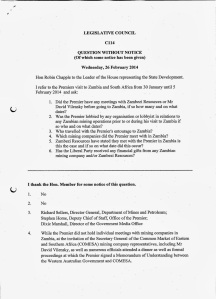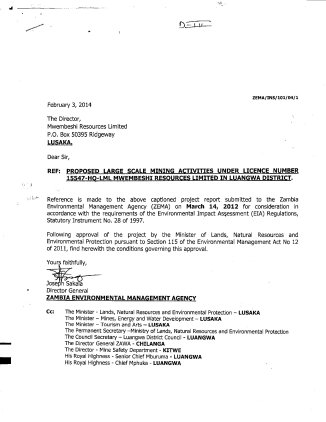PRESS RELEASE
For immediate publication BEFORE 17th November 2014
ZIMBABWE CIVIL SOCIETY SUPPORTS BID TO PREVENT LARGE SCALE COPPER MINING IN LOWER ZAMBEZI NATIONAL PARK, ZAMBIA
Representatives of Zimbabwean civil society have expressed support for their counterparts in Zambia who are opposing the Kangaluwi open-pit copper mining project (and associated road construction) slated for the Lower Zambezi National Park in Zambia. This lies across the Zambezi River from Mana Pools National Park, the Mana Pools/Sapi/Chewore World Heritage Site and the Middle Zambezi Biosphere Reserve) (see attached map).
They are calling on the Zimbabwean Minister of the Environment to engage with his counterpart in Zambia to encourage him to adhere to international law regarding Protected Areas and put a final stop to the controversial proposal.
Zambia’s Environmental Management Agency (ZEMA), the Zambian Ministry of Tourism, traditional leaders, communities, stakeholders and independent experts rejected the project. But in January 2014, Zambia’s then Minister of Lands, Natural Resources and Environmental Protection over-ruled this objection and allowed the project to go ahead. A court challenge was subsequently mounted by the Zambia Community Natural Resources Management Forum (ZCBNRM), putting the project on hold.
The Zambian Court is due to meet for a hearing on the subject this Monday (17th November), to decide if the mining company should be allowed to go ahead anyway, despite opposition.
At the invitation of the Zimbabwe CBNRM Forum and The Zambezi Society, a group of 40 Zimbabwean Civil Society representatives met on 13th November at a briefing workshop in Harare, Zimbabwe and agreed to submit an urgent petition to their Environment Minister. They support the Zambian opposition to this mine for the following reasons:-
1. The project ignores the customary international law obligation arising from Principle 21/2 of the Stockholm and Rio Declarations respectively, which provides that “States have sovereignty over their natural resources and the responsibility not to cause environmental damage to the environment of other states or of areas beyond the limits of national jurisdiction”. It also ignores similar requirements in several SADC Protocols (e.g. Mining, Biodiversity, Shared Watercourses, Wildlife Conservation, Forestry etc). The Lower Zambezi National Park lies within the ZIMOZA Transfrontier Conservation Area (TFCA). Yet there is little evidence of consultation with Zimbabwe or other neighbouring states (e.g. Mozambique) on the potential impacts of this project on them.
2. A dangerous precedent is being set in the region if this mining project is allowed to go ahead.
• The Environmental Impact Assessment (EIA or EIS) for the mine has been independently and expertly reviewed and found to be fundamentally flawed. It was also rejected by Zambia’s Environmental Management Agency (ZEMA). Going ahead with the project undermines the principles of the EIA process.
• International and national legislation has been ignored (even abused) in this case. The mining company (Australian) appears to be attempting to exploit Africa’s resources by taking advantage of loopholes in national legislation and avoiding the accountability that they would face back home.
• An open-cast copper mine allowed to proceed in a major National Park/TFCA in the region and potentially impacting on a neighbouring UNESCO World Heritage Site and Biosphere Reserve opens the door to future mineral exploitation of Protected Areas throughout the region.
3. Apart from impacts within the Lower Zambezi National Park in Zambia, this proposed mine would bring high, long-term risks to the health and well-being of communities, wildlife and environment in Zimbabwe (and Mozambique)
• The scenic, wilderness values of the Zambezi Valley (which have been the base of 50+ years of tourism development in this area on both sides of the river) would be reduced by visual and sound impacts from the mine and associated road infrastructure, spoiling the tourism experience.
• Pollution of ground and surface water by the mine could result in run-off into the Zambezi River, to the detriment of areas and populations downstream, including Zimbabwe’s World Heritage Site and Biosphere Reserve and Lake Cabora Bassa.
• An increased human population into the area from mine and road development will increase human-wildlife conflict situations. Stressed animals are not confined by international boundaries.
• More people in the area will increase wildlife poaching/snaring which is already a cross-boundary problem.
• The position of the mine will block the movement of animals such as wild dog and elephant along the corridor between the Lower Zambezi and South Luangwa National Parks, forcing them into settled lands (increased conflict) or into Zimbabwe or Mozambique.
• All these above impacts would prejudice the UNESCO World Heritage Site and Biosphere Reserve status that Zimbabwe’s Zambezi Valley areas currently enjoy, leading to a loss of almost 50 years of investment towards their ecological integrity. It would also destroy any chance of Zambia succeeding in its bid to achieve similar world recognition for the Lower Zambezi National Park.
• The envisaged life span of the project is about one decade, so the envisaged benefits to the Zambian people are short lived. However, the likely environmental damage to the whole trans-frontier area would be long lasting. This is economically and developmentally irresponsible for the region
Background documents with more detailed information attached herewith:-
a) Map showing location of proposed Kangaluwi Copper Mine
b) Extract from a Discussion Paper on Best Practice Guidelines for Mining in the SADC Region (Zambia as a Case Study) by Yolande Kyngdon-McKay et al
c) CBNRM Forum Mwembeshi EIS Response
d) Comments on Kangaluwi EIS-Kuipers- May 2012
e) Evaluation Report – Mining Lower Zambezi Leigh-Nov 2014
For more information, please contact the following:-
Dr Cecil Muchena (Zimbabwe CBNRM Forum) +263 772 233315
Mrs Sally Wynn (Zambezi Society) +263 772 254462
Prof Chris Magadza (Chair UNESCO Man & Biosphere Cttee, Southern Africa)





